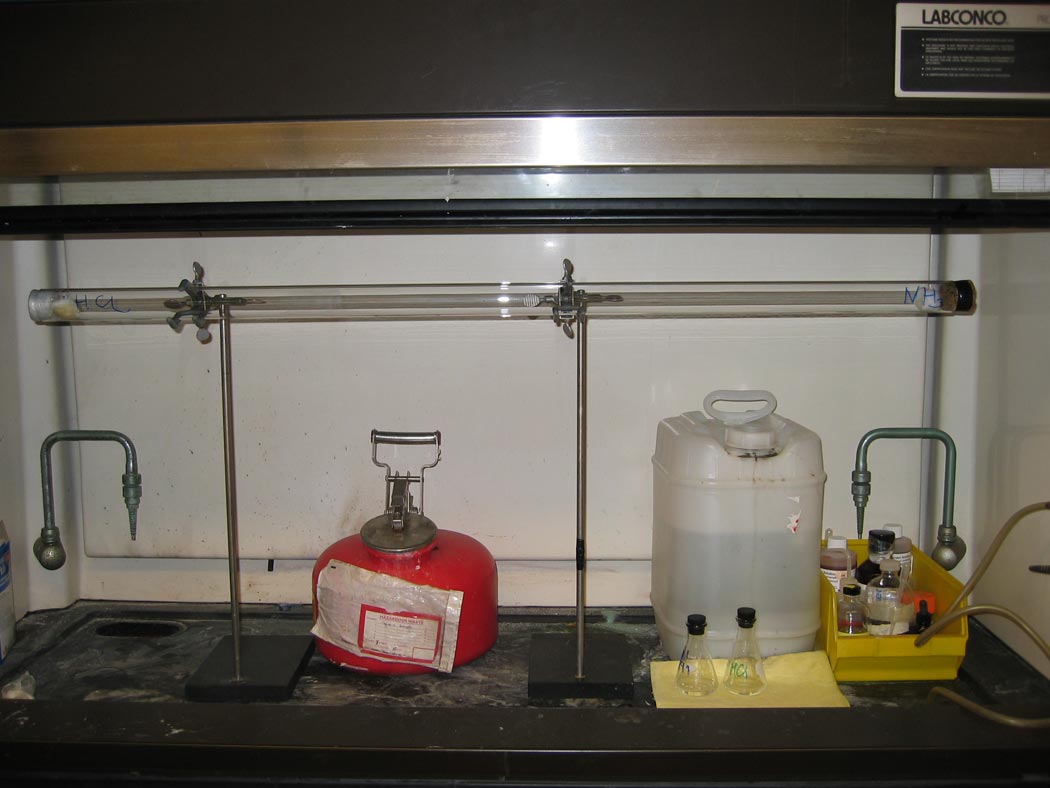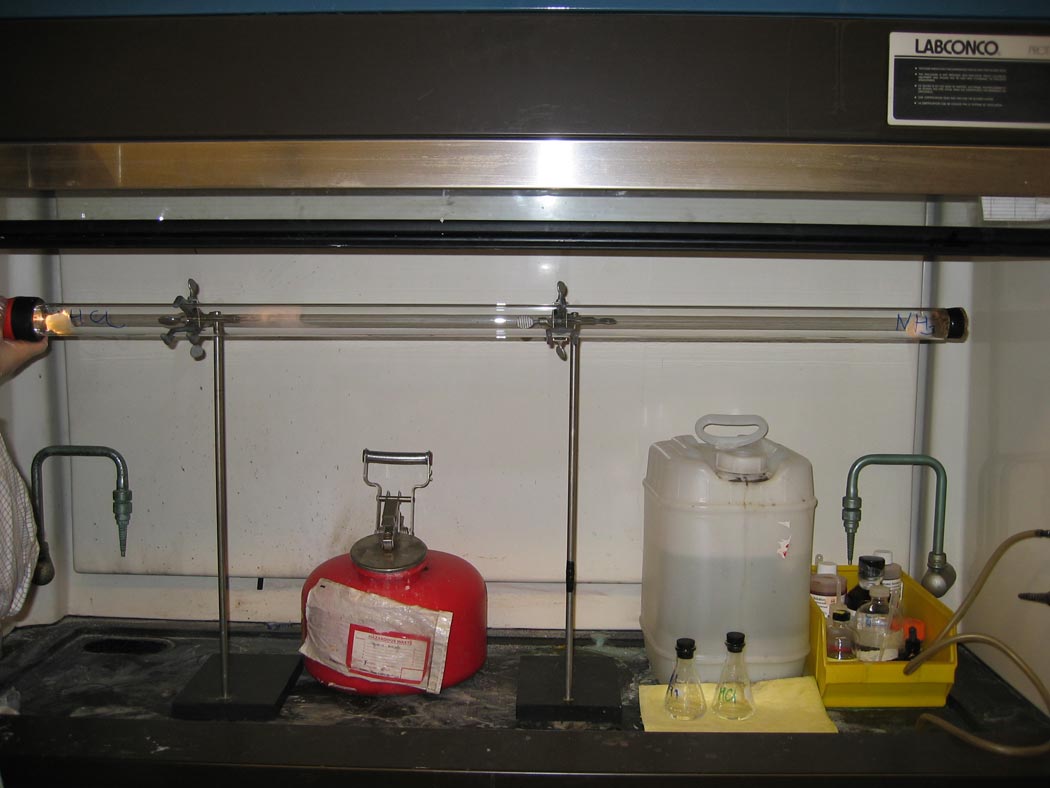The effect of mass on diffusion
 Cotton balls soaked in concentrated solutions of ammonia and hydrochloric acid are introduced into opposite ends of a glass tube. The gases meet and react, forming a white "surface" of ammonium chloride product.
Cotton balls soaked in concentrated solutions of ammonia and hydrochloric acid are introduced into opposite ends of a glass tube. The gases meet and react, forming a white "surface" of ammonium chloride product.
Ingredients: ammonia solution, hydrochloric acid solution, long glass tube, stoppers, cotton balls
Procedure: A complete recipe follows.
1. Soak a few cotton balls in ammonia solution.
2. Soak a few cotton balls in hydrochloric acid solution.
3. Introduce simultaneously the cotton balls on opposing ends of the tube.
4. Seal the tube and wait for the reaction to occur.
5. Mark the point on the tube where the reaction occurs.
Understanding: The macroscopic experience that we have with gases tells us that molecules can diffuse slowly, even when the gas is still. Think of sitting in a room in which the air is calm, and a fragrant perfume or aromatic food is introduced. You know that the smell will reach you, even in the absence of detectable currents of air. You also know that it takes some time for the smell to reach you, perhaps many seconds.
We can use the microscopic kinetic molecular theory of gases to explain how that process occurs. The atoms and molecules that compose the air are moving at great rates of speed. A nitrogen molecule at 25C moves at roughly 475 m/s. That is 1,710 km/hr! That certainly explains how the molecules carrying the aroma can move from one side of the room to the other. But if the molecules are moving so fast, how can it take so long?
The answer is that the molecules carrying the aroma move by a process of diffusion. A good model for diffusion in a gas is something called a random walk. Think of the process of flipping a coin. If it is a head, take a step to the right. If it is a tail, take a step to the left. If you flip the coin many times, the most probable outcome is that you will be close to where you started, having taken an equal number of steps to the right and left. However, you have a probability of having taken more steps to the right than left, or to the left than right.
If we flip a coin N times, the number of heads might be nH and the number of tails will be nT. The total number of flips is equal to N= nH + nT. The difference between the number of heads and the number of tails is J = nH - nT. If we flip the coin many times, the most probable outcome is one with an equal number of heads and tails. However, there is a chance that J will be positive (more heads than tails) or negative (more tails than heads). Think of "J" as the jump in the direction of an excess number of heads (when it is positive) or tails (when it is negative).
One finds that for a very large number of steps, the probability of finding a difference J in the number of heads and tails is well approximated by a normal distribution
probability(J) = (2 π N)-1/2 exp[-J2/2N]
This distribution is also known as the "bell curve" and the "gaussian distribution." The details are interesting.Suppose we take the step size in our random walk to be Δx. The distance moved after taking nH steps right and nT steps left will be x=(nH-nT)Δx=JΔx. From the properties of the normal distribution, we know that the width of the distribution grows as N1/2, so that the probability of stepping away from the center will also grow as N1/2.
Let's take our step in time to be Δt. The time to take N steps in our random walk will be t=NΔt. If we take the probability distribution above, and substitute N=t/Δt and J=x/Δx, we find that the probability of having moved a distance x after a time t is
probability(x) = (2 π Dt)-1/2 exp[-x2/2Dt]
where D=Δx2/Δt is the diffusion constant that measures the rate of diffusion simulated by a random walk. Pretty neat!For the process of diffusion in the gas, the step size Δx is the mean free path
λ = Δx = V/(N π σ2).
The time between steps Δt is the collision time, which is the reciprocal of the collision frequencyZ = 1/Δt = uave/λ.
That leaves us with an estimate of the diffusion constantD=Δx2/Δt=λ2Z = λ uave.
Given this result, we can see that as the mean free path is independent of temperature and mass, the diffusion constant will vary as T1/2 and as M-1/2, just like the the average speed!
 Returning to our experiment, we insert in a long glass tube a source of ammonia, on the right end, and a source of hydrochloric acid, on the left end. The molecules will move through space, undergoing random collisions and moving to a good approximation as a random walk. The concentration of each gas will spread according to the rules of diffusion, moving forward in proportion to the square root of the time. The rate of diffusion will be proportional to the diffusion constant,
D=λ2Z = λ uave, which is inversely proportional to the square root of the molecular mass.
Returning to our experiment, we insert in a long glass tube a source of ammonia, on the right end, and a source of hydrochloric acid, on the left end. The molecules will move through space, undergoing random collisions and moving to a good approximation as a random walk. The concentration of each gas will spread according to the rules of diffusion, moving forward in proportion to the square root of the time. The rate of diffusion will be proportional to the diffusion constant,
D=λ2Z = λ uave, which is inversely proportional to the square root of the molecular mass.
As a result, we can expect the reaction to occur in a position of the tube that is closer to the more massive and slower moving hydrochloric acid, and farther from the lighter and faster diffusing ammonia molecules. Using the molar masses of the two gases, one can show that the reaction will occur at a point 40% of the way from the source of hydrochloric acid and 60% of the way from the source of ammonia.
Prove that result
Question: Suppose that the tube is 122.5 cm in length. Compute the point on the tube where the reaction of the ammonia and hydrochloric acid will first be observed.You can check your answers here.
Suppose the temperature of the tube is lowered -30C. At what point will the reaction occur?
You can check your answers here.
Variations on the theme
Question:
Suppose that the reaction is repeated using solutions of hydroiodic acid and ammonia. The reaction tube is maintained at room temperature, 25C. At what point on the tube will the reaction be observed?